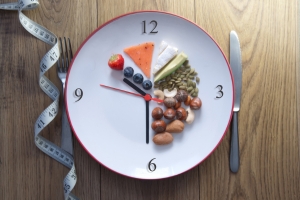Ever feel like you’re on a never-ending rollercoaster of fad diets, only to end up right back where you started (or worse)? I’ve been there too – the cravings, the restrictions, the constant feeling of deprivation. It’s exhausting, isn’t it?
But what if I told you there’s a different way? A way to achieve your fitness goals without sacrificing your sanity or your love for food? Welcome to the world of carb cycling, the sustainable and satisfying approach to healthy living that’s transforming the way people think about nutrition.
Say goodbye to the yo-yo dieting cycle and get ready to embrace a balanced, flexible, and enjoyable way to fuel your body and achieve lasting results.
Carb Cycling Demystified: Your Path to a Healthier You

Carb cycling isn’t about starving yourself or banishing carbs altogether. Instead, it’s a clever strategy that harnesses the power of carbohydrates to fuel your body and achieve your fitness goals.
Think of it as a rhythm: you alternate between days of higher carb intake and days of lower carb intake. On high-carb days, you provide your body with ample energy to power through workouts and replenish glycogen stores. On low-carb days, you encourage your body to tap into stored fat for fuel, promoting weight loss.
But why does this work? Our bodies are incredibly adaptable. By strategically manipulating carb intake, we can influence how our bodies utilize fuel sources. High-carb days stimulate insulin production, which helps shuttle nutrients into cells for energy and muscle building. Low-carb days, on the other hand, encourage the body to switch to burning fat for energy, leading to weight loss.
Here’s a simplified example of how a carb cycling week might look:
- Monday: High-carb day (fueling an intense workout)
- Tuesday: Low-carb day (promoting fat burning)
- Wednesday: High-carb day
- Thursday: Low-carb day
- Friday: High-carb day
- Saturday: Low-carb day
- Sunday: Moderate-carb day (flexibility based on activity level)
Remember, this is just a sample plan. The specifics of your carb cycling schedule will depend on your individual goals, activity level, and preferences. It’s essential to listen to your body and adjust your plan as needed.
But what about the types of carbs you eat? Not all carbs are created equal. On high-carb days, focus on complex carbohydrates like whole grains, fruits, vegetables, and legumes. These provide sustained energy and essential nutrients. On low-carb days, prioritize healthy fats and protein to keep you feeling full and satisfied.
Carb cycling is not a one-size-fits-all approach. It’s a flexible and sustainable way to manage your weight, improve your body composition, and enhance your overall health. So, if you’re ready to ditch the restrictive diets and embrace a balanced approach to nutrition, carb cycling might just be the perfect fit for you!
Unlocking the Power of Carb Cycling

Carb cycling isn’t just another fad diet – it’s a strategic approach with a host of benefits that can revolutionize your fitness journey. Whether you’re aiming to shed those stubborn pounds, sculpt a leaner physique, or simply optimize your overall health, carb cycling offers a powerful toolkit for success.
Here’s a deeper look at the remarkable benefits that carb cycling can unlock:
- Sustainable Weight Loss: Unlike crash diets that leave you feeling deprived and vulnerable to rebound weight gain, carb cycling promotes steady, long-term fat loss. By alternating between high and low-carb days, you keep your metabolism guessing and prevent plateaus.
- Boosted Performance: High-carb days provide the fuel your muscles need for optimal performance during workouts. This translates to increased energy, enhanced endurance, and the ability to push yourself further in your training.
- Improved Body Composition: Carb cycling isn’t just about losing weight – it’s about transforming your body composition. By preserving muscle mass while reducing fat, you’ll achieve a leaner, more toned physique.
- Enhanced Insulin Sensitivity: Regularly cycling your carb intake can help improve insulin sensitivity, which is crucial for blood sugar regulation and overall metabolic health. This can reduce your risk of developing type 2 diabetes and other metabolic disorders.
- Metabolic Flexibility: Carb cycling trains your body to efficiently switch between using carbohydrates and fat for fuel. This metabolic flexibility can improve your body’s ability to adapt to different energy demands and optimize fat burning.
- Reduced Cravings: By strategically incorporating higher-carb days into your plan, carb cycling can help curb cravings and prevent feelings of deprivation. This makes it a more sustainable and enjoyable approach to healthy eating.
But the benefits don’t stop there. Some people report improved mood, better sleep, and increased mental clarity when they adopt carb cycling. It’s a holistic approach that can have a positive impact on various aspects of your well-being.
Of course, like any dietary approach, carb cycling isn’t a magic bullet. It requires consistency, planning, and a willingness to listen to your body’s signals. But for those who are ready to embrace a flexible and effective way to achieve their health and fitness goals, carb cycling offers a world of possibilities.
Ditch the Restrictions, Embrace the Balance

If you’re tired of the “all-or-nothing” mentality of restrictive diets, carb cycling offers a refreshing alternative. It’s not about deprivation or extreme measures, but rather about finding a sustainable balance that nourishes your body and supports your goals.
Here’s why carb cycling stands out from the crowd of fad diets:
- No Food is Off-Limits: Unlike many diets that demonize entire food groups, carb cycling allows you to enjoy a wide variety of foods. It’s about moderation and timing, not complete elimination.
- Say Goodbye to Cravings: By strategically incorporating higher-carb days into your plan, you’ll be less likely to experience intense cravings or feelings of deprivation. This can help you stick to your plan long-term and avoid the dreaded yo-yo dieting cycle.
- Flexible and Adaptable: Carb cycling is not a rigid, one-size-fits-all approach. You can customize your plan to fit your individual preferences, goals, and lifestyle. This makes it a more sustainable and enjoyable way to eat.
- Focus on Whole, Nutritious Foods: While carb cycling allows for flexibility, it’s important to prioritize whole, unprocessed foods whenever possible. Think fruits, vegetables, whole grains, lean proteins, and healthy fats.
- Enjoy the Journey: Carb cycling isn’t about white-knuckling your way through a restrictive diet. It’s about finding a balanced approach that allows you to enjoy delicious food while achieving your health and fitness goals.
By embracing the balance of carb cycling, you’ll n ot only achieve results but also cultivate a healthier relationship with food. It’s a lifestyle shift that can empower you to make informed choices, listen to your body’s signals, and create a sustainable approach to nutrition that you can maintain for the long haul.
Remember, food is meant to be enjoyed. Carb cycling allows you to savor the flavors you love while still making progress towards your goals. It’s time to ditch the restrictions and embrace a balanced approach that nourishes your body, mind, and soul.
Get Started on Your Carb Cycling Journey

Ready to embark on your carb cycling adventure? Fantastic! Here’s your roadmap to kickstart this exciting journey towards a healthier, fitter you:
- Define Your Goals: What are you hoping to achieve with carb cycling? Is it weight loss, improved athletic performance, or overall better health? Having clear goals will help you tailor your plan and stay motivated.
- Assess Your Activity Level: How often and intensely do you exercise? Your activity level will determine how many high-carb and low-carb days you’ll have each week. For example, if you exercise regularly, you might have more high-carb days to fuel your workouts.
- Calculate Your Macros: Macronutrients (macros) are the three main components of your diet: carbohydrates, protein, and fat. To optimize carb cycling, you’ll need to calculate how many grams of each macro you should consume on high-carb and low-carb days. This can be done using online calculators or by consulting a registered dietitian.
- Choose Your Carb Cycling Schedule: There are several different carb cycling schedules you can follow, but the most common is a weekly rotation of high-carb, low-carb, and moderate-carb days. Experiment with different schedules to find one that works best for you.
- Plan Your Meals: This is where the fun begins! Start by creating a list of healthy, whole-food options for each macro category. Then, plan your meals and snacks for the week, ensuring you’re hitting your macro targets each day.
- Track Your Progress: Keep a journal to track your food intake, workouts, and how you feel. This will help you identify patterns, make adjustments, and celebrate your successes.
- Listen to Your Body: Carb cycling is not a rigid set of rules. Pay attention to how your body responds to different carb intakes and adjust your plan accordingly. If you’re feeling sluggish or irritable, you might need to increase your carb intake. Conversely, if you’re not seeing results, you might need to decrease it.
Remember, consistency is key. Stick to your carb cycling plan as closely as possible, but don’t be afraid to make adjustments as needed. And most importantly, be patient and enjoy the process!
Here are some additional tips to help you get started:
- Start Slow: If you’re new to carb cycling, start with a less restrictive schedule, such as two high-carb days and five low-carb days per week. As you get used to it, you can gradually increase the number of high-carb days.
- Drink Plenty of Water: Staying hydrated is essential for overall health and can help curb cravings. Aim for at least eight glasses of water per day.
- Don’t Skip Meals: Skipping meals can lead to blood sugar crashes and overeating later in the day. Make sure to eat regular meals and snacks to keep your energy levels stable.
- Don’t Be Afraid to Ask for Help: If you’re struggling to create a carb cycling plan or are unsure about your macro targets, consult a registered dietitian or certified nutritionist for guidance.
By following these tips and staying committed to your carb cycling journey, you’ll be well on your way to achieving your health and fitness goals.
Your 7-Day Carb Cycling Roadmap to Success
This sample plan is your stepping stone. Remember, listen to your body and adjust as needed.
Monday (High Carb Day)
Breakfast: Oatmeal with Fruit and Nuts (50 grams of carbs)
Snack: Apple with Almond Butter (20 grams of carbs)
Lunch: Salad with Grilled Chicken or Fish (50 grams of carbs)
Snack: Carrot Sticks with Hummus (15 grams of carbs)
Dinner: Pasta with Marinara Sauce (100 grams of carbs)
Tuesday (Low Carb Day)
Breakfast: Eggs with Bacon or Sausage (25 grams of carbs)
Snack: Celery Sticks with Avocado (10 grams of carbs)
Lunch: Salad with Grilled Chicken or Fish (25 grams of carbs)
Snack: Handful of Almonds (15 grams of carbs)
Dinner: Steak or Salmon with Roasted Vegetables (25 grams of carbs)
Wednesday (High Carb Day)
Breakfast: Waffles with Fruit and Syrup (75 grams of carbs)
Snack: Rice Cakes with Peanut Butter (20 grams of carbs)
Lunch: Sandwich on Whole-Wheat Bread with Lean Protein and Vegetables (75 grams of carbs)
Snack: Trail Mix with Nuts and Dried Fruit (30 grams of carbs)
Dinner: Pizza with Whole-Wheat Crust and Vegetables (125 grams of carbs)
Thursday (Low Carb Day)
Breakfast: Eggs with Avocado (25 grams of carbs)
Snack: Bell Pepper Slices with Guacamole (10 grams of carbs)
Lunch: Salad with Grilled Chicken or Fish (25 grams of carbs)
Snack: Cheese Stick with Grapes (15 grams of carbs)
Dinner: Salmon with Roasted Vegetables (25 grams of carbs)
Friday (High Carb Day)
Breakfast: Pancakes with Fruit and Syrup (75 grams of carbs)
Snack: Rice Cakes with Peanut Butter and Banana (30 grams of carbs)
Lunch: Sandwich on Whole-Wheat Bread with Lean Protein, Vegetables, and Cheese (85 grams of carbs)
Snack: Popcorn with Parmesan Cheese (30 grams of carbs)
Dinner: Pasta with Marinara Sauce and Meatballs (140 grams of carbs)
Saturday (Low Carb Day)
Breakfast: Greek Yogurt with Fruit and Nuts (25 grams of carbs)
Snack: Cucumber Slices with Cottage Cheese (10 grams of carbs)
Lunch: Salad with Grilled Chicken or Fish (25 grams of carbs)
Snack: Hard-boiled Egg (5 grams of carbs)
Dinner: Chicken or Tofu Stir-fry with Vegetables (25 grams of carbs)
Sunday (High Carb Day)
Breakfast: Cereal with Milk and Fruit (100 grams of carbs)
Snack: Banana with a Tablespoon of Sunflower Seeds (30 grams of carbs)
Lunch: Rice Bowl with Grilled Chicken or Fish (100 grams of carbs)
Snack: Smoothie with Fruit, Yogurt, and Protein Powder (40 grams of carbs)
Dinner: Black Bean Soup with Cornbread (150 grams of carbs)
Remember: This is just a guide. Customize your meal plan based on your calorie needs and preferences.
So, are you ready to ditch the diet drama and embrace a lifestyle that truly nourishes your body and soul? Carb cycling isn’t just a passing trend – it’s a sustainable, science-backed approach that can transform your health and fitness journey.
By understanding the power of carbohydrates, harnessing the flexibility of alternating carb intake, and prioritizing whole, nutritious foods, you’ll be well on your way to achieving your goals – whether it’s shedding those extra pounds, boosting your athletic performance, or simply feeling your best.
Remember, this is your journey, and carb cycling is your trusty companion. Embrace the balance, listen to your body, and enjoy the delicious ride to a healthier, happier you!
The Science Behind Carb Cycling
While anecdotal evidence and personal experiences abound, scientific research on carb cycling is still emerging. However, some studies have explored the potential benefits of this dietary approach:
- Improved Body Composition: A study published in the Journal of the International Society of Sports Nutrition found that carb cycling in conjunction with resistance training led to greater fat loss and preservation of lean muscle mass compared to a traditional low-carb diet.
- Enhanced Athletic Performance: Research suggests that high-carb days can help replenish glycogen stores, which are crucial for energy during intense workouts. This can improve performance and reduce muscle fatigue.
- Metabolic Flexibility: Some studies suggest that carb cycling may enhance metabolic flexibility, the body’s ability to switch between using carbohydrates and fat for fuel. This could have implications for weight management and overall metabolic health.
However, it’s important to note that more research is needed to fully understand the long-term effects of carb cycling and its impact on different populations.
If you’re considering trying carb cycling, it’s always recommended to consult with a healthcare professional or registered dietitian to ensure it aligns with your individual needs and goals.
For further reading:
- Carb cycling: Benefits, evidence, and how to do it – Medical News Today: https://www.medicalnewstoday.com/articles/carb-cycling
- What is Carb Cycling and How Does it Work? – Healthline: https://www.healthline.com/nutrition/carb-cycling-101
- Ask the Expert: Carb Cycling for Weight Loss – Today’s Dietitian: https://www.todaysdietitian.com/newarchives/0718p10.shtml










2 Responses
I’ve tried so many diets, but carb cycling is the first one that feels sustainable and effective! This no-deprivation approach is a game-changer. I love that I can still enjoy my favorite carbs on certain days without feeling guilty. The results have been amazing – I’ve lost weight and gained energy without the constant hunger and cravings. Highly recommend this diet to anyone looking for a balanced and enjoyable way to lose weight!
Thank you so much for sharing your experience! We’re thrilled to hear that carb cycling is working well for you and that you’re seeing great results. Our aim is to provide diet plans that are not only effective but also enjoyable and sustainable. It’s wonderful to know that you can enjoy your favorite carbs without feeling deprived. Keep up the fantastic work, and don’t hesitate to reach out if you have any questions or need further support. We’re here to help!